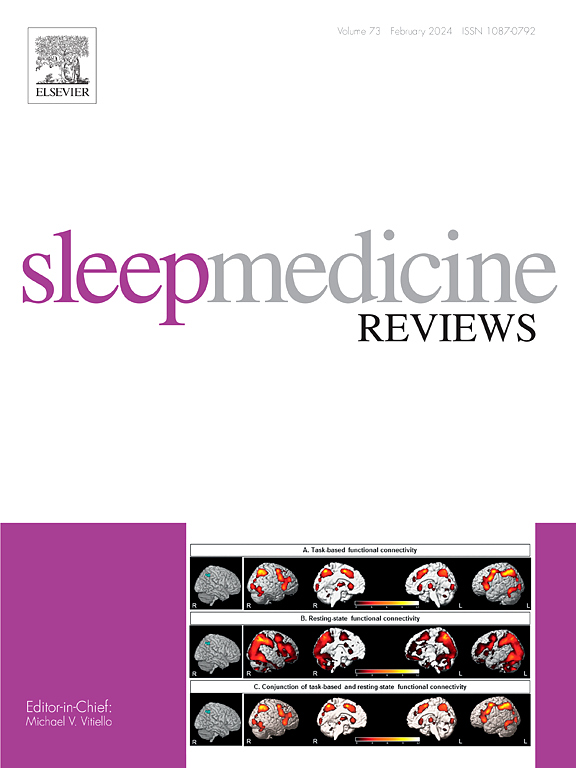Neural correlates of insomnia with depression and anxiety from a neuroimaging perspective: A systematic review
IF 9.7
1区 医学
Q1 CLINICAL NEUROLOGY
引用次数: 0
Abstract
Insomnia affects a substantial proportion of the population and frequently co-occurs with mental illnesses including depression and anxiety. However, the neurobiological correlates of these disorders remain unclear. Here we review magnetic resonance imaging (MRI) studies assessing structural and functional brain associations with depressive and anxiety symptoms in insomnia disorder (ID; n = 38), insomnia symptoms in depressive and anxiety disorders (n = 14), and these symptoms in the general populations (n = 3). The studies on insomnia disorder consistently showed overlapping (salience network: insula and anterior cingulate cortex) and differential MRI correlation patterns between depressive (thalamus, orbitofrontal cortex and its associated functional connectivity) and anxiety (functional connectivity associated with default mode network) symptoms. The insula was also consistently identified as indicating the severity of insomnia symptoms in depressive disorder. In contrast, findings for other regions related to insomnia symptoms in both depressive and anxiety disorders were generally inconsistent across studies, partly due to variations in methods and patient cohorts. In the general population, brain regions in the default mode network provided a functional link between insomnia and depressive symptoms. These findings underscore both the shared and distinct neural correlates among depression, anxiety, and insomnia, providing potential avenues for the clinical management of these conditions.
从神经影像学角度看失眠与抑郁和焦虑的神经相关性:一项系统综述
失眠影响了相当大比例的人口,并且经常与包括抑郁和焦虑在内的精神疾病共存。然而,这些疾病的神经生物学相关性仍不清楚。在此,我们回顾了磁共振成像(MRI)的研究,评估了失眠障碍(ID;N = 38),抑郁和焦虑障碍中的失眠症状(N = 14),以及这些症状在一般人群中的表现(N = 3)。失眠障碍的研究一致显示抑郁(丘脑、眶额皮质及其相关功能连接)和焦虑(与默认模式网络相关的功能连接)症状之间的重叠(突出网络:岛叶和前扣带皮层)和差异MRI相关模式。脑岛也一直被认为是抑郁症中失眠症状严重程度的标志。相比之下,在抑郁症和焦虑症中与失眠症状相关的其他区域的研究结果在研究中通常不一致,部分原因是方法和患者队列的差异。在一般人群中,默认模式网络中的大脑区域提供了失眠和抑郁症状之间的功能联系。这些发现强调了抑郁、焦虑和失眠之间的共同和独特的神经相关性,为这些疾病的临床管理提供了潜在的途径。
本文章由计算机程序翻译,如有差异,请以英文原文为准。
求助全文
约1分钟内获得全文
求助全文
来源期刊

Sleep Medicine Reviews
医学-临床神经学
CiteScore
20.10
自引率
3.80%
发文量
107
期刊介绍:
Sleep Medicine Reviews offers global coverage of sleep disorders, exploring their origins, diagnosis, treatment, and implications for related conditions at both individual and public health levels.
Articles comprehensively review clinical information from peer-reviewed journals across various disciplines in sleep medicine, encompassing pulmonology, psychiatry, psychology, physiology, otolaryngology, pediatrics, geriatrics, cardiology, dentistry, nursing, neurology, and general medicine.
The journal features narrative reviews, systematic reviews, and editorials addressing areas of controversy, debate, and future research within the field.
 求助内容:
求助内容: 应助结果提醒方式:
应助结果提醒方式:


